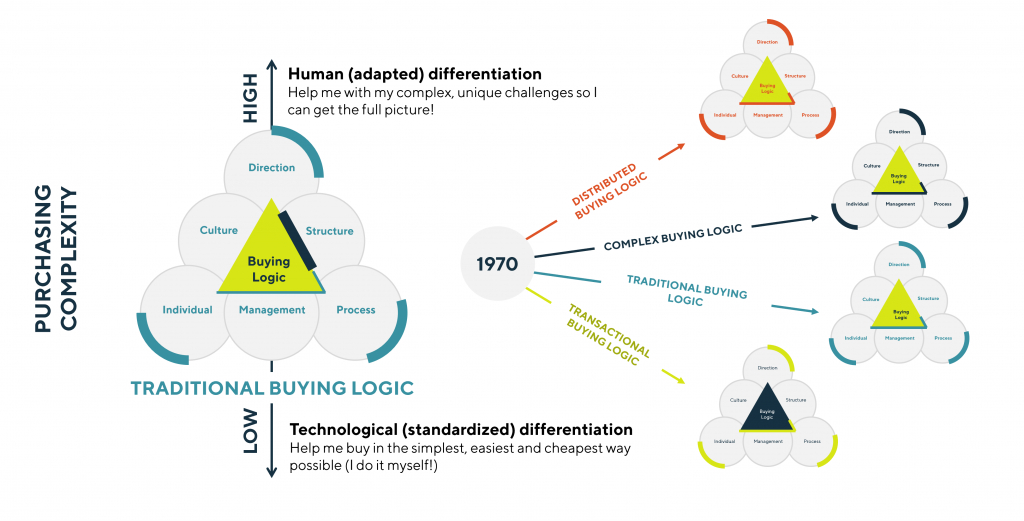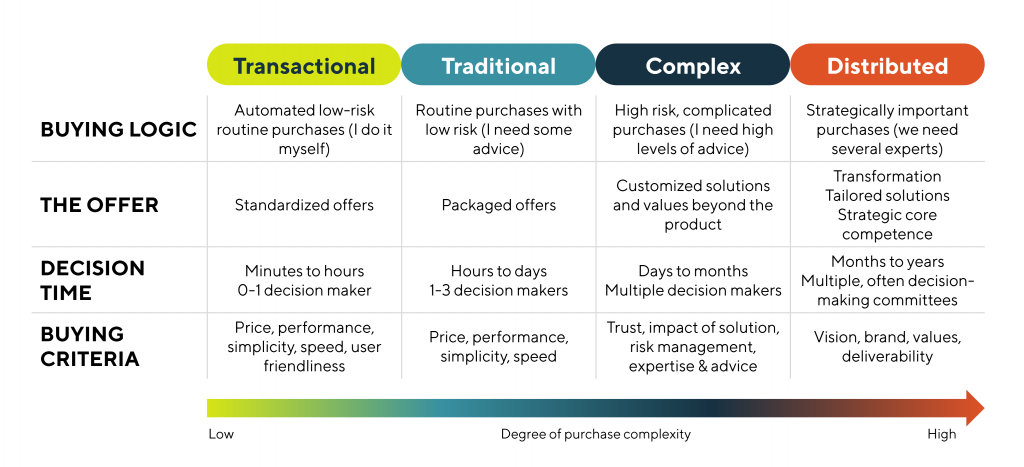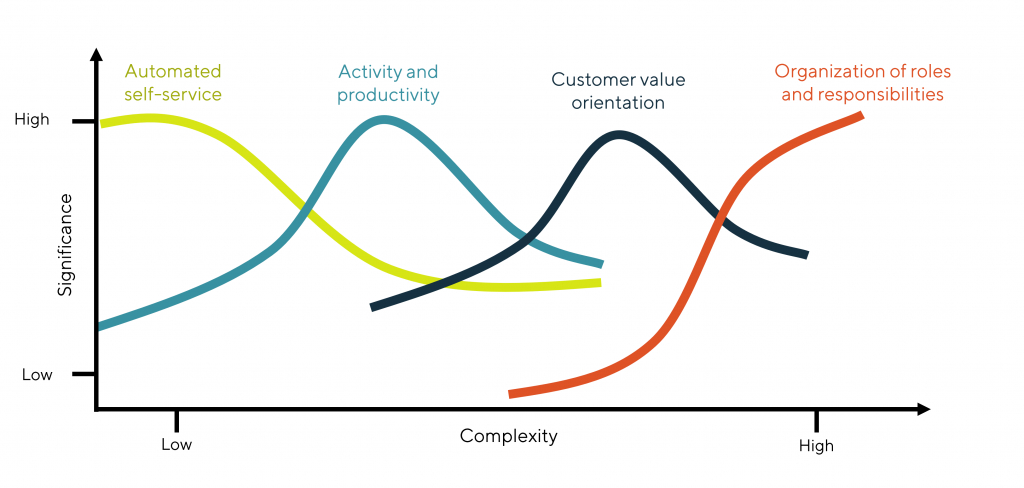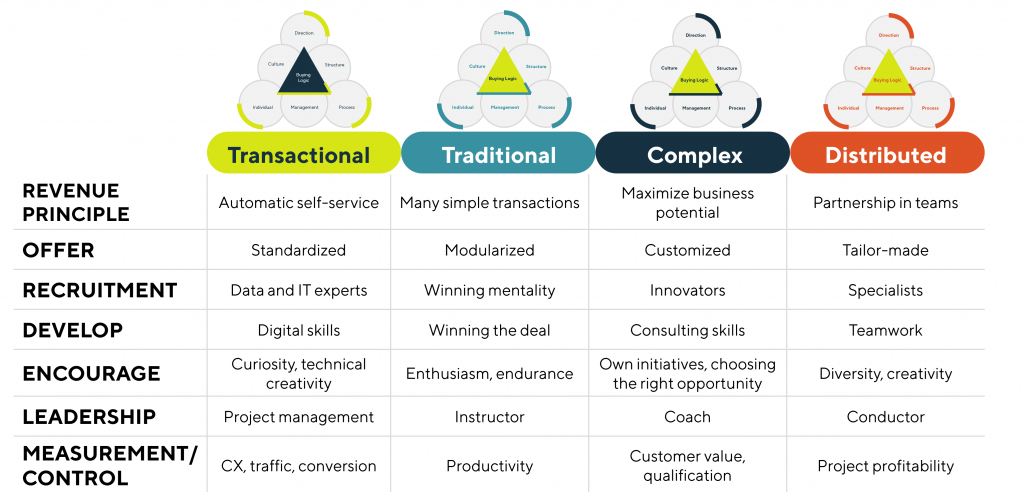Buying logic behind sales strategy choices
Have you ever wondered why that one salesperson who was so successful at their last employment is not performing in your organization? Or why the reward model that used to be so effective no longer works? Don’t worry, there is a logical explanation to this. It’s probably that the customer’s buying logic is playing tricks on you. Through Mercuri research, we can show that it is your ability to match sales logic with the customer’s buying logic that determines how well your strategy contributes to increased sales and profitability.
All too often we get questions along the lines of: “Which salesperson should I recruit?”, “Which is the best reward model for us?”, “How and in what should we train our salespeople?”, “Which sales methodology should we choose?” or “Which CRM system is the best on the market?”. The answers to these and many other questions are: “it depends”. There is no single recipe for success in sales, as often seems to be the case when reading blogs and articles on sales. There are several dependencies on the customer’s buying logic and, as the title indicates, it is the match with your selling logic that determines which strategy to choose.
Polarization of buying logic – the changing buying behaviors of customers
There are numerous articles on the changing buying behavior of customers. Digitalization, and now AI-based language models such as ChatGPT, have undoubtedly changed our behavior in terms of how we acquire information, what channels we use, who we ask for advice, and how we compare and evaluate products, services, and suppliers. Since 2000, Mercuri International has followed the development of B2B trade and in particular the trend where we see a strong polarization between buying logics, i.e. how B2B customers buy goods and services. Customers increasingly want (and are used to) obtaining information, evaluating, and ordering goods and services on their own without the involvement of salespeople. Here, technological developments, the potential for automation, the increasing availability of information, and customer demand for simplicity, speed and affordability have accelerated and are increasingly replacing the traditional volume sales of simple services and standardized products. Several studies show that our behavior as consumers spills over into how we act as professional B2B buyers.
Customers are thus increasingly choosing what we in our research call a ‘transactional buying logic’ where the customer in practice conducts the buying process on their own without the need to interact with a salesperson. Thus, in this type of ‘do-it-yourself’ business, customers obtain information on their own and finally place their order via, for example, an e-commerce platform. For many salespeople, who have historically dealt with this type of customer in a traditional way, this means being outcompeted by digital marketing, algorithms, and modern technology.
While traditional sales are being eroded by transactional automated sales, we see another polarizing trend. Businesses are also becoming increasingly complex. When large companies do business with each other and complex solutions are sold, the ceiling for the customer’s perception of risk and effort in a purchase is also raised. In other words, the more difficult or riskier the customer perceives the purchase to be, the more effort is required. More decision-makers will be involved, the buying process will take longer, and the effort will be more demanding. Success in this type of business requires completely different success factors to create profitability and growth.

The customer’s perception of risk and value (complexity) determines the logic of the sale
Since 2005, Mercuri International has run one of the world’s largest research projects in terms of hours and scope of studies. The Sales Efficiency Study confirms that there is an overarching rule that governs all sales and gives rise to four distinct buying and selling logics.
For each deal, it is the buyer’s perception of risk and value in the deal that determines the logic of the sale.
Starting from the buyer and the buyer’s experience of the transaction is a perspective that is necessary for understanding the basic logic of selling. It is the buyer and the buyer alone who determines the complexity of the sale – the riskier they perceive the deal to be, the more complex it becomes.

Mercuri International’s sales logic model is thus based on the complexity of the business; it is the complexity of the business that determines how sales should be conducted in order to be successful in the long term. The complexity of a transaction is determined by the customer’s effort (in terms of time, money and security) to obtain the value of the seller’s offer and the risk of losing that effort (i.e. the risk of not obtaining the expected value). In particular, it is the loss of security that drives complexity, or rather it should be said that it is the customer’s loss of security that most strongly indicates the complexity of the transaction.
Examples of factors that can drive the customer’s perception of risk and effort:
- Purchase costs are of course always a consideration for the customer, but price sensitivity decreases as the buyer’s efforts increase.
- Engineering includes all the work involved in project planning, feasibility studies, analysis, scheduling, etc. The more engineering the purchase requires, the greater the complexity and risk of losing time and money.
- Embedding includes all efforts to create urgency, understanding and interest in the offer. It also includes all the work of explanation, pedagogy, mobilization, education, training and coaching. The more embedding required, the greater the complexity.
- Integration is the process of making old and new work in harmony and symbiosis. It is not only about technology and systems, but above all about processes, procedures, workflows, working methods, roles and responsibilities, incentives, etc. The more integration the new solution requires, the greater the complexity
- Follow-up refers to the time needed for evaluation, quality assurance, knowledge transfer, documentation, and further improvement measures. The more follow-up, the greater the complexity.
- All change creates a certain amount of doubt, hesitation, and anxiety. What happens next? How should we use this? What if I can’t do it? Why should we do this? All this means loss of productivity. When employee productivity falls, so does profitability. The more concerns, the higher the complexity.
So. The more the seller’s offer influences the customer, the more change is required for the customer to get the expected value from the purchase, the more time, money, and security the customer has to risk.
Complex transactions are transactions where the buyer’s perception of both risk and value is significant. Complexity is essentially about how customer-specific the deal is. The more specific to the buyer’s business that the deal, the problems, and the solution are, the more serious the whole deal becomes for the buyer – because the more customized the deal is, the more it is anchored in the buyer’s unique situation and the more it interferes with the buyer’s business operations and development. The more customized the deal is, the larger and more complex the seller’s workload becomes – there are concerns and other factors to consider; more people have to be consulted and provide input or approval on various components of the deal; more issues have to be addressed and more aspects negotiated. When the deal is complex, the purchase decision has far-reaching consequences for the buyer’s future business. The seller must analyze the buyer’s unique situation and identify not only the buyer’s needs and problems but also the consequences of different proposed solutions. Complex selling can therefore be said to be more about business and organizational development.
When deals become very complex, a single salesperson cannot cope, the sales work must be distributed among several people, and the organization of teamwork immediately becomes the key success factor. The selling company still has to succeed in customization, but since the business process is a team effort, issues of division of labor, management and group dynamics become dominant. Deals that are so complex that they have an impact on the global economy place no small demand on teamwork.

The success factors and relationships illustrated in the figure above are based on a solid empirical foundation. Transactional selling is about using all technological possibilities to make it as easy and time-efficient as possible for the customer to buy. It is simply about automating as many parts of the buying process as possible, e.g. using marketing automation, content marketing, videos, blogs, DIY guidelines, chatbots, online marketing, automated quotes and self-ordering features. Where the customer is willing and able, and the customer’s risk is low, this is a preferred sales strategy.
In traditional sales, with its more or less simple transactions, it is the number of transactions that constitutes the success criterion for a salesperson. The success factor is therefore the salesperson’s drive – the competitive instinct, belief in success, enthusiasm, and perseverance together with the ability to quickly build trust and engage the customer to closure. More recently, this role has also evolved, and in many cases been replaced, by a digital inside salesperson or marketer who uses modern technology for prospecting (e.g. social selling) and effective customer meetings (e.g. video meetings).
In complex sales, where each deal represents a major investment for the seller, it is important to close each deal. The success factor is therefore the consultative ability of the seller – the ability to build relationships, to understand the customer and identify their problems and needs, and to craft value-creating and distinctive solutions that make them unique. It can also be noted that as complexity increases, so does the importance of being able to choose the right deal. The ability to qualify correctly is therefore crucial. The time and resources that the seller must invest in a complex business process are not trivial – and should not be invested without careful strategic consideration. This capacity for discernment, although secondary to the dominant factors of success, is by no means insignificant. A tertiary success factor in more complex deals is the creativity of salespeople and the diversity of sales organizations. Indeed, all complexity research shows that any phenomenon that deserves the label ‘complex’ is also inherently surprising and unpredictable. Complex business processes will bring surprises, and that’s when salespeople need to be able to perform at their best and adapt to the new situation.
In distributed selling, where every deal is critical, teamwork is crucial. The success factor is therefore the ability of the sales organization to organize and lead this teamwork.

Sales logic guides your choice of sales strategy
As you have probably noticed by now, understanding the logic in which you operate is crucial to building a robust and adequate sales strategy. This is a strategic choice that you have to make. What products and services do you want and need to sell? Should you focus on standardization or customization? Should you focus on one or several logics (which require a lot of organization)? In theory, it is simple. Sales strategy is about matching how customers want to buy (buying logic) with how we should sell (selling logic). In practice, it is much more difficult. “Sending the right salesperson, with the right offer, to the right customer, on the right business opportunity with the right support and coaching from the organization” is not a trivial task. Mercuri International’s long-term research in this area, based on countless studies and interviews with more than 6,000 salespeople, shows that sales organizations have problems. Only 15% of all companies in the study succeed in the art of matching customers’ buying logic with adequate selling logic. That this figure is so low is often based on not having a well thought-out customer segmentation that leads to the right organization with the right governance model and incentives.
This is both a serious and costly problem that results in sales organizations not being creative enough to respond to customer and market changes. The consequences are lower customer satisfaction, lower employee satisfaction, higher costs and lower margins, turnover, and growth.
Want to know more?
Get in touch with us to find out how we can deliver innovative training solutions tailored to your company, your business, and your specific needs. We help you build successful sales teams and grow as a business based on your circumstances through training and new skills.


